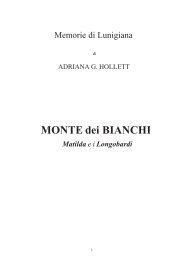Filattiera e la sua Pieve - Memorie di Lunigiana
Filattiera e la sua Pieve - Memorie di Lunigiana
Filattiera e la sua Pieve - Memorie di Lunigiana
You also want an ePaper? Increase the reach of your titles
YUMPU automatically turns print PDFs into web optimized ePapers that Google loves.
An outline of the history of the <strong>Lunigiana</strong><br />
Region<br />
In order to summarize briefly the history of the origins of the <strong>Lunigiana</strong><br />
Region, it is necessary, due to scarce documentation, to resort to the work of<br />
Eugenio Branchi “Storia del<strong>la</strong> <strong>Lunigiana</strong> feudale” (“History of the <strong>Lunigiana</strong><br />
Region in feudal times”), the only authoritative source together with the work of<br />
Gioachino Volpe; in this regard, it was Volpe who observed, “the history of the<br />
<strong>Lunigiana</strong> Region, before the twelfth century, is little more than shadows and<br />
tenuous light of a <strong>di</strong>stant dawn”.<br />
In accordance with these authors, we begin with Oberto, count of Luni,<br />
probably of Lombar<strong>di</strong>c descent and the only surviving member of the family of<br />
the marquis of Tuscany.<br />
Luni became a Roman colony in 177 B.C., prospered with the name of<br />
Provincia Maritima Italorum (Italian Maritime Province), at first, subjected to<br />
Lombar<strong>di</strong>c invasion, then, with all of the <strong>Lunigiana</strong> Region, was aggregated to the<br />
Lombar<strong>di</strong>c dukedom of Lucca. With the Franks, Luni entered into the Carolingian<br />
march (border<strong>la</strong>nd), Oberto was its first count and, <strong>la</strong>ter, when the Bishops<br />
opposed the dominion of the Obertenghi family, obtaining from Federico I,<br />
sanction of their rights on all of the territory, it became a bishop’s see.<br />
Volpe, in agreement with other historians and genealogists, singles out in<br />
Oberto (945), the first historical figure to be nominated count of Luni. To be count<br />
of Luni had a certain importance, as the town, located between Liguria and<br />
Tuscany, bore witness through the remains of its Roman amphitheatre and ancient<br />
Pa<strong>la</strong>eolithic settlements, to its remarkable past. Oberto, a few years <strong>la</strong>ter (951), as<br />
well as the <strong>Lunigiana</strong> Region, entered into possession of the march of eastern<br />
Liguria, of the centres of Tortona and Genoa and, upon his death, all of his<br />
possessions were passed by him to his two sons: Adalberto I and Oberto II.<br />
The first son, by successive ramifications, gave rise to the lineages of the<br />
marquis of Massa, Corsica and Sar<strong>di</strong>nia, of the Pe<strong>la</strong>vicino and of the Cavalcabo`<br />
of Cremona. The second son Oberto I, the one of greater interest to <strong>Lunigiana</strong>’s<br />
8







